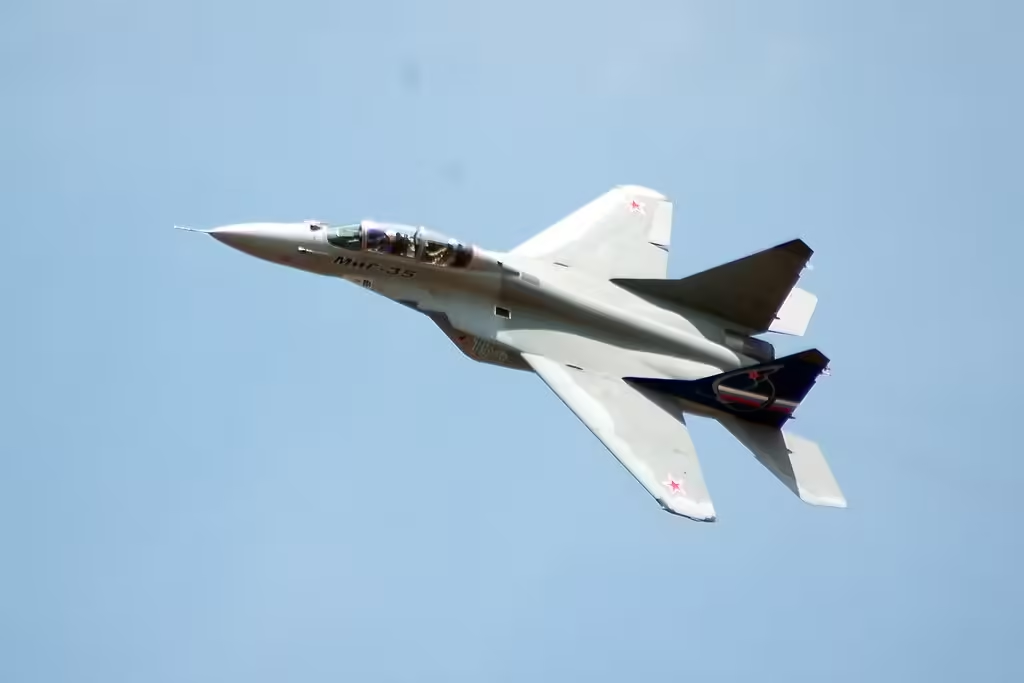
Table of Contents
Summary and Key Points: Despite the Kremlin’s promotion of the MiG-35 Fulcrum-F as a fifth-generation fighter, it has not lived up to expectations.

-Of the 37 units that were supposed to be produced, only six were actually produced. The MiG-35 was not exported to the 2022 China International Aviation and Aerospace Exhibition because it could not attract overseas customers.
-The MiG-35 has a sophisticated radar and can carry a wide range of payloads, but its engine power and stealth capabilities are inferior to the American F-35 Lightning II.
-The ongoing conflict in Ukraine has further strained Russia’s resources, making additional production of the MiG-35 unlikely.
The MiG-35’s Unfulfilled Potential: Challenges and Comparison
The Fulcrum-F fighter jet, while marketed by the Kremlin as a “fifth-generation” platform, has not lived up to expectations. In reality, only six of the thirty-seven units that Moscow originally intended to build were produced. At the 2022 China International Aviation and Aerospace Exhibition, the Russian Air Force debuted the MiG-35 alongside the country’s Su-35, Su-57, and Su-34 aircraft. The Fulcrum-F platform is comparable to China’s Chengdu J-20 and America’s F-35 Lightning II fighter jets, but has not yet been exported, despite Kremlin efforts to convince potential foreign customers.
The MiG-35’s origin story
At the Aero India Air Show in 2007, Russia initially displayed a prototype of the MiG-29 in an attempt to sell the new aircraft to New Delhi. But in the end, when superior competitors such as the Eurofighter Typhoon, Boeing F/A-18 Super Hornet, Saab JAS 39, and Dassault Rafale became available, the platform’s radar and engine problems forced it out of the race. At the Sokol aircraft facility in Russia, manufacturer Mikoyan continued to produce the export version of the fighter, which was released years later in 2019.
Perhaps its most notable feature is that the Fulcrum-F was the first Russian aircraft to be fitted with an active electronically scanned array radar at the time of its launch. Air Force Technology: claims that the Zuk-MA radar can provide a wide air target detection radius. OLS gives the MiG-35 radar-like target detection and weapon targeting capabilities.
However, OLS lacks emissivity, making it undetectable unlike radar. By first acquiring the image and then processing it, OLS works similar to the human eye. Engineers of the National Institute of Astronomy and Research (NII PP) selected additional short-wave bands for the matrix, which greatly increased the sensitivity and detection range of the complex. The addition of this improved radar sets the MiG-35 apart.
The MiG-35 vs F-35
The MiG-35 was designed to carry large amounts of weapons. With its nine hardpoints, the jet can carry a combination of Kh-31P anti-radar missiles, Kh-31A anti-ship missiles, KAB-500Kr TV-guided bombs and Kh-29TE missiles. With these qualities, if properly equipped, the Fulcrum-F could prove a useful weapon in air superiority operations. In contrast, its missile payload is installed only half that of the F-35 Lightning II.

But the Pratt & Whitney F135 engine, which powers the American fifth-generation platform, is far more powerful than the MiG-35. The MiG-25’s FADEC RD-33MK engines are an improvement over the earlier Kimov RD-33 turbofan engines, though still inferior to their American equivalents. The Lightning II has a clear edge in terms of stealth.
Since only six MiG-35s are in circulation today, it is difficult to gauge the potential use of this platform by the Russian Air Force down the line. The ongoing Ukraine invasion continues to use up Moscow’s resources and funds so the country is unlikely to produce additional Fulcrum-Fs in the near future.

About the Author: Maya Carlin
Maya Carlin is a national security writer for The National Interest. She was previously an Anna Sobol Levy Fellow at IDC Herzliya in Israel and is an analyst at the Center for Security Policy. Her byline has been used by numerous publications such as The National Interest, The Jerusalem Post, and The Times of Israel.
READ | Repeat: Russia’s Su-34 fullback fighter-bomber nightmare is real


1 thought on “The MiG-35 fighter nightmare in Russia can’t be fixed just yet”